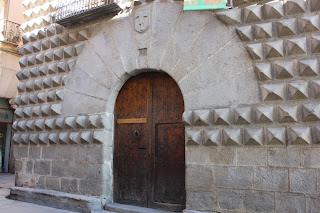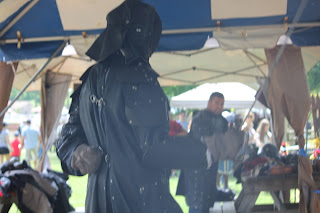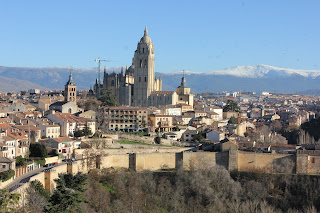The mountains that cross central Spain are beautiful. I saw them mainly from the window of the train. These and the mountains between Salamanca and Segovia were my inspiration for some of the scenes of the countryside in my story, though fictionalized.
I find the exposed stone and the alternations between the barren and forested areas remarkable.
We had a different view when we went to Segovia, with higher mountains and snow in one direction, and a vast plain on the other. Segovia is located where two rivers come out of the highlands to make a naturally defensible spot.
The following photos link into a panorama of the plain.
Here they are stitched together.
Friday, October 23, 2015
Wednesday, October 14, 2015
The House of Spikes
One of the remarkable houses of Segovia is called the Casa de los Picos, or House of Spikes. The front of the house is covered with remarkable granite points. It seems the house was older, with a standard facade and courtyard, and the granite facade was added later.
The house gained this appearance between about 1465 and 1500, which is the time frame I am using for the inspiration for the story of Diego.
The arched doorway is typical of the region for that time period, and is the same in Salamanca, though this is particularly grand example.
There are various stories about why the house was given this appearance, from a desire to change its name to a means to express a "medieval rudeness and surliness." The house was located right by the original entry gate to the city (demolished in the 19th century). I expect the house was built as a grand and unforgettable display for everyone who entered the city, with perhaps some measure of warning about the danger or prickliness of the residents of the house.
One of the remarkable houses of Segovia is called the Casa de los Picos, or House of Spikes. The front of the house is covered with remarkable granite points. It seems the house was older, with a standard facade and courtyard, and the granite facade was added later.
The arched doorway is typical of the region for that time period, and is the same in Salamanca, though this is particularly grand example.
The windows have a tiny balcony in front, allowing a bit of access to the outside when the shutters are open, but not really enough to fully stand on.
Both the main door and the windows have a symbol over them, representing the family that added this remarkable facade, the la Hoz family. The literal translation is sickle or reaping hook; to me, this looks like a billhook, which is a pruning device for fruit trees.
Wednesday, September 23, 2015
City Walls
Salamanca has some remnants of its medieval walls, evidence for the endemic violence of the medieval period. The large scale violence of the Christian conquest of the high middle ages, or the Reconquista, gave way to factional violence between the various political entities of Iberian Peninsula. The walls are only extant in a few places. There are probably a variety of reasons for this. Part may have been tied to the destruction of the Alcazar (city fortress) when the city chose the wrong side in a factional battle in the sixteenth century. Part is due to the inconvenience of a big stone wall when there is no need for it anymore. Part is the re-use of those stones in new construction. But like many medieval cities, from York to Granada, you can find and walk along some of the old walls from the middle ages. Some of the walls of Salamanca are built directly on bedrock, where the city sat on the stone cliffs above the Rio Tormes.
The walls of Segovia are in better repair than Salamanca, in part because the medieval aspect of the city is a reason for tourism. Between the Alcazar and the cathedral, plus the association with the coronation of Queen Isabella, Segovia draws a medieval crowd. It also has the amazing Roman aqueduct, so masonry is an important part of Segovia's material heritage. The walls, which are remarkable intact, or at least repaired and renovated, can be found surrounding most of the old city.
Thursday, September 10, 2015
The streets of the Juderia in Segovia seems narrower, and at least some of the houses seem taller and narrower than elsewhere in the old city. I used this distinction in my story when Diego goes and visits the armor maker, which also served to give me some ideas about the characters who lived in that area.
Tuesday, September 1, 2015
Friday, August 21, 2015
Anton van den Wyngaerde was a Flemish artist of the 16th century. I first encountered his work with his Panorama of London made in 1543. He was employed for quite some time in Spain, so there are many of his panoramas of Spanish cities.
This is the 1562 panorama of Segovia. This view is looking north from the old cemetery on the opposite hill, which is why there are graves being dug in the foreground.
This view is from a slightly different spot (I think Wyngaerde was farther west), but pretty close. The tower is the Church of St Michael (Iglesia San Miguel), just east of the Cathedral. The roof has changed but the tower itself is recognizable. The hillside is now wooded, making a panorama difficult at best.
Wednesday, August 19, 2015
Residential towers are common among the elite residences of Salamanca and Segovia. I have used this as a model for a variety of places in the story.
This is the Torreon de Lozoya, on the Plaza of San Martin in Segovia. It was built in the 14th-16th century. Several other palaces are also located on the plaza. Here is another with a much smaller tower.
This is the Tower of Hercules, named for the mythical founder of Segovia. It was first built in the 13th century. It was the residence of the Arias de la Hoz family until 1513 when it became a Dominican convent.
Here is a closer view of the upper portion of the Tower of Hercules.
Tuesday, August 18, 2015
Chapter 2 begins with Diego working in his garden. Most medieval and many modern cities have gardens around the margins, where the city-dwellers can grow their vegetables because the dense urban fabric makes it impossible to do so by their home.
These are the gardens outside Segovia, covered with frost in the early hours of a January morning. A fragment of wall is visible in the foreground.
The walls of Segovia on the path to the gardens.
Monday, August 17, 2015
I have long loved the artistry that is such a big part of Spanish architecture. The melding of different traditions brings a real vitality to the spaces within the buildings. Sometimes the exteriors are grand as well, while sometimes it is mainly on the interior.
This is the chapel in the Alcazar of Segovia. Note on the left the lattice-work screen. This was originally a privacy screen, mainly so the queen could observe services without being looked at by others in the chapel. I adapted this idea for one part of the story in Torremonte.
The other side of the screen, with a seven-year old for scale.
Friday, August 14, 2015
Spanish rapier fencing or sword fighting is slightly different from English or Italian swordplay from the same time period. This site by Richard Marsden has a basic introduction if you would like to see how it works. The overall system is called Destreza.
If you're not interested in that level of detail, simply put, the Spanish system is centered around the idea of a circle which surrounds each participant. That circle is defined by where you can move and where you can strike with your sword. If you move, your circle moves with you (this is something which seems to get lost in translation). You plan your action based on the circle. The circle is most important for what is called the curved step. There are also questions of blade control, distance, and timing, which differ in various ways from other countries.
I have also looked at Fiore's Armizare and have a certain measure of practice as well to aid in understanding how rapiers were used in combat.
Here I am at the New Jersey Renaissance Fair (2015) fencing against my wife. It was very silly but fun.
If you're not interested in that level of detail, simply put, the Spanish system is centered around the idea of a circle which surrounds each participant. That circle is defined by where you can move and where you can strike with your sword. If you move, your circle moves with you (this is something which seems to get lost in translation). You plan your action based on the circle. The circle is most important for what is called the curved step. There are also questions of blade control, distance, and timing, which differ in various ways from other countries.
I have also looked at Fiore's Armizare and have a certain measure of practice as well to aid in understanding how rapiers were used in combat.
Here I am at the New Jersey Renaissance Fair (2015) fencing against my wife. It was very silly but fun.
Wednesday, August 12, 2015
I recently read A Darkling Sea by James L. Cambias. I liked it, and would recommend it. The story is fundamentally about a group of humans studying an alien society in the ocean under the ice of a distant planet's moon. I found the story engaging because Jim created a set of characters that you wanted to know more about and see what happened as the story progressed. I particularly liked how he presented the aliens from their own perspective: they were both alien and accessible, which is a hard thing to do.
I have known Jim a long time, and know how much effort he puts into his ideas and thoughts on alien species. I think this novel does a great job creating a truly alien view, while not making it so alien as to be inaccessible. I picked this up while on a trip to Saratoga Springs, and stayed up too late each night as I wanted to know what was coming next in the story.
Another piece of Jim's work I really liked is his story The Alien Abduction. This link has a blurb about it. It was published in 2000 in Fantasy and Science Fiction Magazine.
I have known Jim a long time, and know how much effort he puts into his ideas and thoughts on alien species. I think this novel does a great job creating a truly alien view, while not making it so alien as to be inaccessible. I picked this up while on a trip to Saratoga Springs, and stayed up too late each night as I wanted to know what was coming next in the story.
Another piece of Jim's work I really liked is his story The Alien Abduction. This link has a blurb about it. It was published in 2000 in Fantasy and Science Fiction Magazine.
Tuesday, August 11, 2015
Here is one of the residential towers from a fortified house complex built around 1440. It originally had four towers, but the other three were removed in the early modern period. This is the Torre del Aire, also called the Palacio de los Fermocelle, in Salamanca.
Monday, August 10, 2015
An except from Chapter 2:
Climbing further long the crest,
Diego went higher up the hill. He paused a moment to look at Torremonte. The
city sat perched on a parallel crest, the great tower of the keep at the
highest point of the hill, which gave the city its name. Below the tower, the
city fanned out like the folds of a lumpy dress, at least from where Diego
stood. The “hem” was the walls and towers of the defenses of the city, marked
by the gates. There were seven gates in all, and from his vantage Diego could
see three of them, no, four. Each was controlled by one of the noble families
of the city, collecting tolls from all who entered the city. Diego did not use
the gates, but a narrow gap at the base of one of the older towers which was
big enough to climb through. He had little enough money, and he certainly would
not use any of it to make the nobles even richer.
The scene was inspired by this view of Segovia, from the pine grove on the opposite hill.
Here is a link to a You Tube video. It is Canarios by Gaspar Sanz, played on the baroque guitar by Diogo Rodrigues.
Canarios played by Diogo Rodrigues
Canarios played by Diogo Rodrigues
Here are a few images from Spain.
Brick and Half-timber construction.
An elaborate wooden door.
Part of the University of Salamanca.
Cathedral of Salamanca
Carvings on the Cathedral of Salamanca.
Dragon carving on the Cathedral
Residential tower, originally 14th-15th century. Torre de los Anaya.
Fortified residence, Casa de las Viejas. This was turned into a House of Charity for widows in the 17th century. Now it is a film library.
Coffered ceiling
Church of the True Cross (Vera Cruz), Segovia
Great Hall, Alcazar, Segovia
Part of the Armory, Alcazar, Segovia
Cathedral and walls of Segovia
Paella
Bread.
Subscribe to:
Posts (Atom)























































